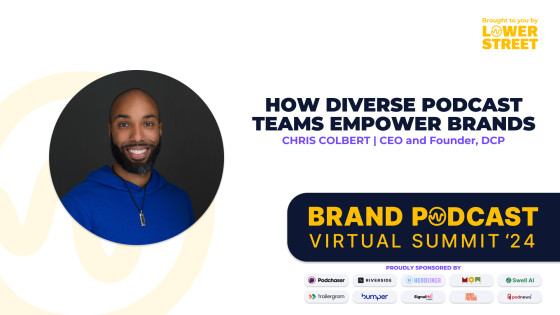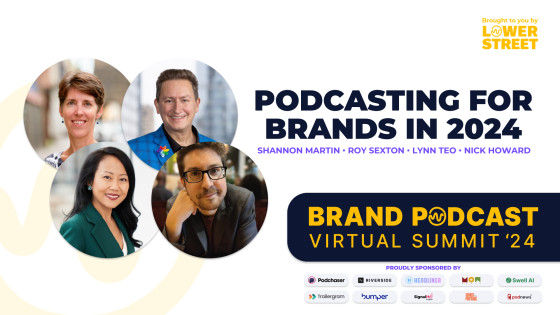Turn Your Internal Team Into Podcast Superfans
Contents

Once a month, Lower Street opens our doors for a one-hour session with an industry expert sharing insights to answer your most pressing questions about brand podcasting. In November, we had the pleasure of hosting Stevie Manns, audio producer and brand consultant for BlackRock's The Bid podcast.
Stevie shared how they were able to convert BlackRock employees into superfans and evangelists of The Bid, ultimately boosting the reach and effectiveness of the podcast by leveraging internal channels at the firm.
Launched in 2018, The Bid is BlackRock’s flagship podcast, designed to explore macroeconomic topics such as trends in AI, inflation, cryptocurrency, and more. The show was built to reach people with a sphere of influence– politicians, C-suite executives, journalists, academics, and finance industry leaders– and build brand favorability by providing insights, timely content, and analysis that showcases BlackRock’s expertise.
Turning a Challenge into an Opportunity
When mapping out promotion plans for the year, Stevie was met with a new challenge: their promotion budget had been reallocated to other initiatives within the firm.
It’s a common challenge many branded podcasts face, especially when the show has been around for a while. But rather than accepting the loss and resigning to a year of sluggish growth, Stevie saw an opportunity to focus on what they could control: building BlackRock’s internal audience.
With BlackRock’s large employee base—around 25,000 people across 73 global offices —Stevie saw huge untapped potential.
Of course, employees of BlackRock are not the target audience for The Bid. However, Stevie saw that by turning employees into superfans, they wouldn’t just be increasing downloads of the podcast. They’d also be creating evangelists for The Bid, who would share the podcast widely.
The Superfan Model
Drawing from their experience in the music industry, Stevie adopted a model based on the principle that you only need a small group of superfans to drive meaningful success. In music, for example, an artist can sustain a career with just 100 superfans.
This might seem small, but these superfans attend every event (and bring their friends), buy merch (and wear it, acting as a “billboard” for your music), and continuously stream songs (including around their friends).
For The Bid, the idea was similar: turn BlackRock employees into superfans, and they’ll spread the word about the podcast to external audiences– those in the target demographic, like C-suite executives and finance professionals.
The Superfan Journey
So, how can you go about turning your internal team into superfans?
Stevie recommends starting by identifying the segments within your internal audience, and thinking carefully about:
Their current exposure (or lack thereof) to the podcast
Why the podcast would be relevant to them
Here’s how that looked for The Bid:
New Employees: Junior (Gen Z)
New hires that are early in their career are usually very keen on the firm and have done lots of research already. They might have already checked out the podcast, and have definitely already checked out the YouTube page.
They are keen to learn as much as possible about the firm and get a better understanding of the leadership’s vision, meaning the podcast would be a great resource for them.
New Employees: Senior (Millennial/ Gen X, Boomers)
They might be new to podcasting as a medium, and likely haven’t heard of the podcast before.
The podcast could help them become more familiar with the BlackRock brand specifically, introducing them to the firm’s priorities in comparison to other firms.
Veteran Employees: Junior (2-5 years)
They may have heard about the podcast in an internal newsletter at some point, but probably aren’t familiar with the show.
They could use the podcast to stay more up-to-date on the markets to help them move up in their careers.
Veteran Employees: Senior (2-5+ years)
They probably heard about the podcast when it first launched, but aren’t familiar with the latest version of the show.
The podcast could provide them with more current information to help them stay relevant and avoid being stale in their roles.
From there, Stevie developed a Superfan listener journey to model how to reach these unique audience groups and take them from the discovery phase, into superfans. Here’s how Stevie structured this path:
Discovery (days 1-7): Introduce the podcast to employees during the onboarding process and through mandatory training. Employees are made aware of the podcast’s existence.
Casual Listener (0-3 months): Employees see The Bid around the office (via signage, intranet, screensavers, and Zoom backgrounds), listen to at least one episode, and start to get familiar with the content.
Regular Listener (3-6 months): Employees begin to recognize The Bid as a reliable source of leadership insights and market trends. They check out episodes that align with their interests and can explain the podcast’s relevance in casual conversations.
Superfan (6-12 months): At this point, employees regularly listen to all new episodes, and also recommend the podcast to colleagues or clients. They are keen to interact with the podcast.
Building the Superfan
Once this listener path was established, Stevie had to build a plan for leveraging internal channels to reach employees at every stage in this Superfan journey. Here’s how they tailored that engagement for each phase:
1. Discovery: Find Them
Introduce new employees to the podcast through onboarding packets, podcast presence during intern/ analyst introduction days, and ongoing mandatory training sessions.
2. Casual Listener: Inform Them
Keep the podcast top-of-mind through signage around the office, on the company intranet, and in screensavers. Demonstrate how the content is valuable to employees by highlighting relevant episodes in newsletters, TikToks, and LinkedIn posts. Encourage employees to listen to episodes that are most relevant to their careers.



3. Regular Listener: Connect With Them
Gather feedback from employees on what they like about the show, and offer exclusive perks like exclusive live events, competitions, and giveaways. Opportunities to win a lunch with the host or behind-the-scenes access can deepen that engagement with employees.



4. Superfan: Make Content With Them
Invite employees to co-produce episodes, contribute questions, or come into the studio for recording sessions. Collaborate with Employee Resource Groups (i.e. the Women’s Network, the Black Professionals Group, the LGBTQ+ Network) for episodes surrounding their initiatives to encourage further sharing to their large networks.


Low-Hanging Fruit
As Stevie’s example emphasizes, there’s huge potential in leveraging your internal audience. For brands making podcasts, it’s essential to turn your marketing focus inward and turn your employees into podcast superfans.
While your employees may not be your primary target audience, they are a powerful resource to reach that target audience by empowering your team to share the podcast with their connections.
Plus, by leveraging your internal resources to get the podcast in front of your team, you can involve them in the content production process. They can help shape the content, making it even stronger and more relevant.
Brands often overlook the low-hanging fruit of targeting their own internal teams. But this can be a huge opportunity to grow the podcast and build a loyal, long-term fan base. The more invested your internal audience is, the more they’ll help your brand and podcast reach the next level.
Want Even More Brand Podcast Insights?
Stevie’s presentation was part of Lower Street’s Monthly Office Hours sessions. Every month an expert comes on to look at a new perspective of brand podcasting: your artwork, podcasting in academia, using your internal audience, etc. Then we open the floor to get all your questions answered. Every event is totally free. Check out the upcoming events here.
Thinking about launching a podcast for your brand?
If you need a hand launching, producing, or promoting your branded podcast, the Lower Street team is here to help. Get in touch for a free consultation.
Contact us




